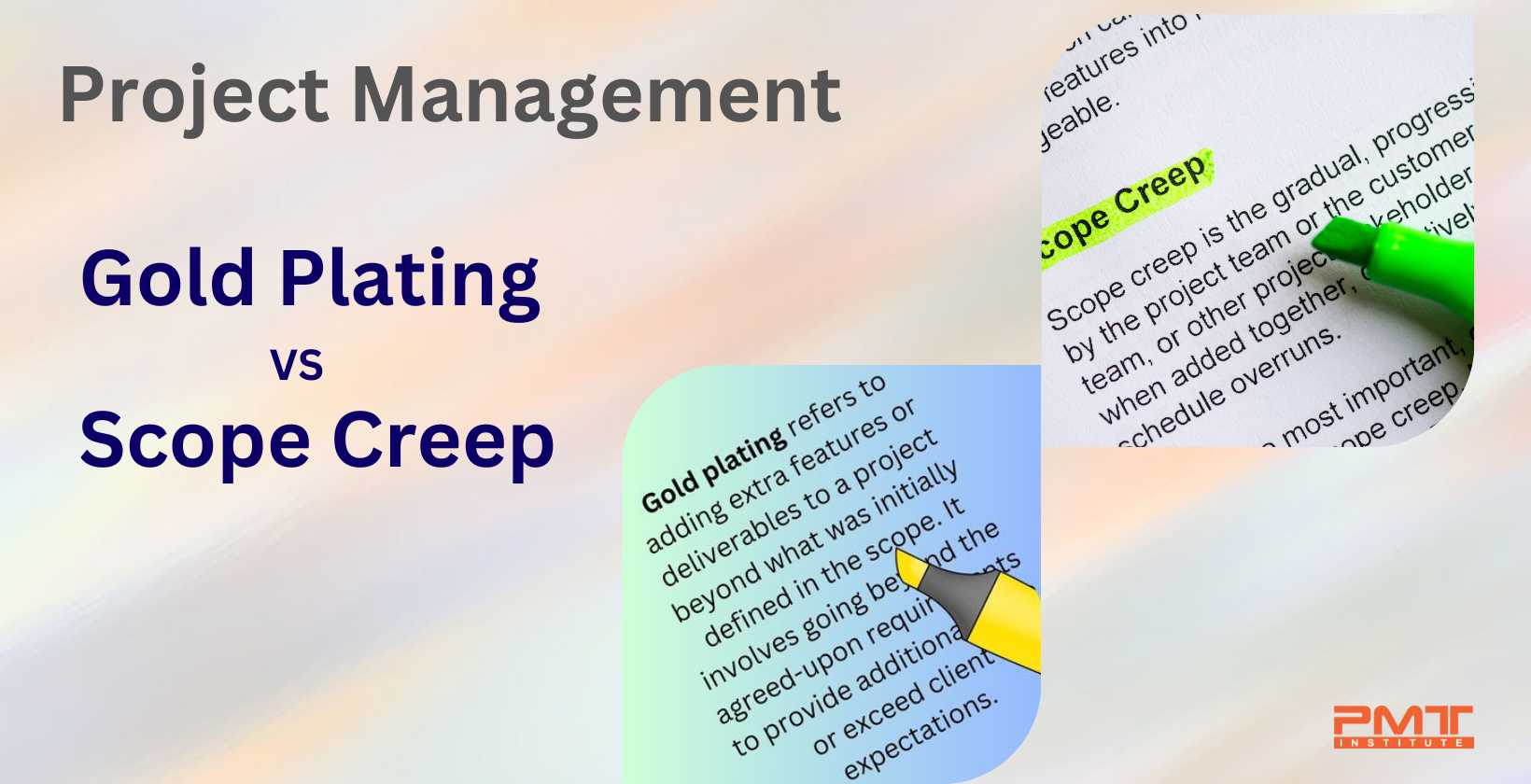Gold Plating vs Scope Creep
Published:
Updated:

In project management, managing project scope is critical to ensure successful project delivery. However, project managers face two common challenges: gold plating and scope creep. Gold plating refers to adding extra features or deliverables beyond what was initially agreed upon, while scope creep refers to an uncontrolled expansion of project scope.
This blog aims to provide a comprehensive understanding of gold plating and scope creep, highlighting their definitions, examples, and impacts on project management. Whether you are preparing for the Project Management Professional (PMP) exam or seeking to enhance your project management skills, understanding the differences between gold plating and scope creep is essential.
Gold Plating in Project Management
Definition of Gold Plating
Gold plating refers to adding extra features or deliverables to a project beyond what was initially defined in the scope. It involves going beyond the agreed-upon requirements to provide additional value or exceed client expectations.
Examples of Gold Plating in Project Management
-
Adding unnecessary design enhancements to a software application that were not requested by the client.
-
Incorporating additional features in a product prototype without proper justification or customer demand.
-
Including supplementary reports or data analysis in a market research project without client approval.
Scope Creep in Project Management
Definition of Scope Creep
Scope creep refers to the uncontrolled expansion or growth of project scope without proper evaluation, approval, or documentation. It occurs when new requirements, features, or deliverables are added to the project without considering the impact on project timelines, resources, and objectives.
Examples of Scope Creep
-
Requesting additional functionalities for a software application during the development phase without evaluating the impact on the project schedule.
-
Expanding the scope of a construction project by adding new rooms or features without reassessing the budget and timeline.
-
Increasing the number of deliverables in a marketing campaign without considering the availability of resources and the impact on project deadlines.
Differentiating Gold Plating and Scope Creep
Intention
Gold Plating: Gold plating is often driven by the desire to exceed client expectations or provide additional value.
Scope Creep: Scope creep occurs unintentionally when the project scope is not adequately managed or controlled.
Approval and Documentation
Gold Plating: Gold plating is usually done without proper approval or documentation, as it involves adding extra features beyond what was agreed upon.
Scope Creep: Scope creep can occur with or without proper approval, but it typically lacks proper documentation, leading to uncontrolled scope expansion.
Impact on Project
Gold Plating: Gold plating may result in increased project costs, extended timelines, and potential misalignment with project objectives.
Scope Creep: Scope creep can lead to project delays, cost overruns, resource exhaustion, and compromised project quality.
Managing Gold Plating and Scope Creep
|
Managing Gold Plating |
Managing Scope Creep |
|
|---|---|---|
|
Prevention |
- Clearly define project requirements and deliverables |
- Establish a robust change control process |
|
Communication |
- Foster open and transparent communication with stakeholders |
- Engage stakeholders in ongoing discussions |
|
- Manage stakeholder expectations |
- Continuously monitor project scope changes |
|
|
Change Management |
- Implement a formal change request process |
- Evaluate and document all scope changes |
|
- Assess change requests for feasibility and impact |
- Prioritize and evaluate scope change requests |
|
|
- Obtain proper approvals and evaluations before implementing changes |
- Communicate approved scope changes to all stakeholders |
|
|
Monitoring |
- Regularly review project deliverables against the defined scope |
- Monitor project scope against the scope baseline |
|
- Identify and address any unauthorized additions or changes |
- Conduct ongoing scope reviews and audits |
|
|
- Educate project team members about gold plating risks |
- Proactively manage and control project scope |
|
|
Stakeholder |
- Engage stakeholders in project scope discussions |
- Ensure stakeholder involvement and agreement on scope changes |
|
Involvement |
- Seek stakeholder input on project requirements and changes |
- Regularly communicate scope changes to stakeholders |
Impact on Project Management
Project Success
Gold Plating: Gold plating can undermine project success by diverting resources, causing delays, and increasing project costs.
Scope Creep: Scope creep can lead to project failure by compromising project timelines, resources, and the ability to deliver within budget.
Stakeholder Satisfaction
Gold Plating: While gold plating may initially result in positive stakeholder feedback, it can lead to dissatisfaction if it negatively impacts project objectives, timelines, or budget.
Scope Creep: Scope creep often results in stakeholder dissatisfaction due to uncontrolled changes, increased project costs, and extended timelines.
Project Control and Monitoring
Gold Plating: Proactive project control and monitoring can help identify instances of gold plating and take corrective actions to realign the project with its defined scope.
Scope Creep: Effective project control and monitoring processes are essential to identify and manage scope creep, ensuring that changes are evaluated, approved, and documented appropriately.
Mitigating Gold Plating and Scope Creep
Effective Requirements Gathering
Thoroughly understanding and documenting project requirements at the outset is crucial to prevent gold plating and scope creep. Conducting comprehensive stakeholder interviews, engaging in active communication, and utilizing requirement-gathering techniques such as workshops and prototyping can help ensure a clear and accurate understanding of client expectations.
Scope Definition and Baseline
Clearly define the project scope and document it in a scope statement or project charter. Include specific deliverables, objectives, and boundaries to minimize the likelihood of gold plating or scope creep. Establishing a well-defined scope baseline ensures that any changes or additions to the scope are evaluated against the agreed-upon criteria.
Change Control Procedures
Implement robust change control procedures to manage requests for additional features or changes to the project scope. Establish a formalized process that includes evaluating the impact of the change, assessing its alignment with project objectives, obtaining necessary approvals, and documenting the change request. This helps prevent unauthorized scope changes and ensures that all modifications are properly evaluated and documented.
Stakeholder Engagement and Communication
Active engagement and effective communication with stakeholders is key to managing gold plating and scope creep. Regularly involve stakeholders in scope discussions, seek their input, and provide updates on project progress. By maintaining transparency and involving stakeholders in decision-making, you can manage expectations, address concerns, and minimize the likelihood of scope-related issues.
Ongoing Scope Monitoring
Continuously monitor project scope throughout the project lifecycle. Regularly review project deliverables, assess progress against the defined scope baseline, and compare actual work performed to planned work. This allows project managers to identify any instances of gold plating or scope creep and take timely corrective actions.
Educating Project Team Members
Ensure that project team members understand the importance of adhering to the agreed-upon project scope. Educate them about the risks and impacts associated with gold plating and scope creep. Encourage a proactive mindset that focuses on delivering within the defined scope and discourages any unauthorized additions or changes.
Project Management Tools and Techniques
Utilize project management tools and techniques to manage project scope effectively. Tools such as project management software and collaboration platforms can aid in documenting and tracking project scope. Techniques like work breakdown structure (WBS) and regular progress reviews help monitor the scope and detect any deviations or potential gold plating.
Continuous Risk Management
Integrate risk management practices into project planning and execution. Identify potential risks related to gold plating and scope creep, assess their impact and likelihood, and develop strategies to mitigate or respond to them. By proactively managing risks, project managers can minimize the chances of scope-related issues.
Impacts of Gold Plating and Scope Creep
Time Delays
Both gold plating and scope creep can lead to project delays. Gold plating involves spending additional time on tasks that were not originally planned, while scope creep adds new tasks or requirements to the project, extending the project timeline. These delays can affect overall project scheduling and potentially lead to missed deadlines.
Increased Costs
Gold plating and scope creep often result in increased project costs. Gold plating requires additional resources and efforts that were not accounted for in the initial budget, leading to cost overruns. Scope creep introduces new tasks or requirements, necessitating additional resources and potentially exceeding the allocated budget.
Resource Exhaustion
Uncontrolled gold plating or scope creep can strain project resources. Extra work resulting from gold plating may overload team members and lead to burnout. Scope creep can require additional resources beyond what was initially planned, causing resource shortages and impacting overall project efficiency.
Stakeholder Dissatisfaction
Both gold plating and scope creep can negatively impact stakeholder satisfaction. Gold plating may create false expectations, as stakeholders may assume that additional features are part of the original scope, leading to disappointment when those features are not delivered. Scope creep can lead to dissatisfaction due to uncontrolled changes that may compromise project objectives or delay project completion.
Compromised Quality
Uncontrolled additions or changes to the project scope can compromise the quality of project deliverables. Gold plating may divert resources from critical tasks, resulting in reduced quality in core project deliverables. Scope creep may stretch resources thin, leading to rushed work and compromised quality across the entire project.
Conclusion
In project management, managing project scope is crucial for successful project delivery. Gold plating and scope creep are two common challenges that project managers face, each with its own implications and impact on project outcomes. Gold plating involves adding extra features beyond the agreed-upon scope, often driven by the desire to exceed client expectations. Scope creep, on the other hand, refers to the uncontrolled expansion of project scope without proper evaluation and documentation.
Understanding the differences between gold plating and scope creep is vital for project managers to effectively manage project scope, control project timelines, and budgets, and ensure stakeholder satisfaction.
By implementing best practices for scope management, project managers can mitigate the risks associated with gold plating and scope creep, thereby increasing the likelihood of project success.

